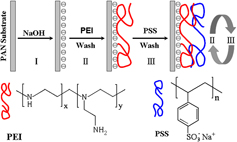Crossref Citations
This article has been cited by the following publications. This list is generated based on data provided by
Crossref.
Cai, Botai
Gu, Pei
Zeng, Lixi
Zhou, Ying
Liu, Qingju
Li, Xun
Yuan, Longfei
and
He, Yujian
2014.
Highly efficient co-removal of heavy metals in wastewater from chemical oxygen demand testing instrument by cysteine-functionalized magnetic nanoparticles.
Chemical Research in Chinese Universities,
Vol. 30,
Issue. 3,
p.
472.
Wei, Xiuzhen
Wang, Songxue
Shi, Yingying
Xiang, Hai
and
Chen, Jinyuan
2014.
Application of Positively Charged Composite Hollow-Fiber Nanofiltration Membranes for Dye Purification.
Industrial & Engineering Chemistry Research,
Vol. 53,
Issue. 36,
p.
14036.
Guo, Hongxia
Sun, Pengzhi
Liang, Yucang
Ma, Yiwen
Qin, Zhenping
and
Cui, Suping
2014.
In-situ fabrication of polyelectrolyte-CSH superhydrophilic coatings via layer-by-layer assembly.
Chemical Engineering Journal,
Vol. 253,
Issue. ,
p.
198.
Laakso, Timo
Kallioinen, Mari
Pihlajamäki, Arto
Mänttäri, Mika
and
Wong, John-Erik
2015.
Polyelectrolyte multilayer coated ultrafiltration membranes for wood extract fractionation.
Separation and Purification Technology,
Vol. 156,
Issue. ,
p.
772.
Guo, Hongxia
Ma, Yiwen
Sun, Pengzhi
Cui, Suping
Qin, Zhenping
and
Liang, Yucang
2015.
Self-cleaning and antifouling nanofiltration membranes—superhydrophilic multilayered polyelectrolyte/CSH composite films towards rejection of dyes.
RSC Advances,
Vol. 5,
Issue. 78,
p.
63429.
Guo, Hongxia
Chen, Mengmeng
Liu, Qiang
Wang, Ziming
Cui, Suping
and
Zhang, Guojun
2015.
LbL assembly of sulfonated cyclohexanone–formaldehyde condensation polymer and poly(ethyleneimine) towards rejection of both cationic ions and dyes.
Desalination,
Vol. 365,
Issue. ,
p.
108.
Shan, Linglong
Guo, Hongxia
Qin, Zhenping
Wang, Naixin
Ji, Shulan
Zhang, Guojun
and
Zhang, Zhongguo
2015.
Covalent crosslinked polyelectrolyte complex membrane with high negative charges towards anti-natural organic matter fouling nanofiltration.
RSC Advances,
Vol. 5,
Issue. 15,
p.
11515.
Qin, Zhenping
Ren, Xiaoyan
Shan, Linglong
Guo, Hongxia
Geng, Changle
Zhang, Guojun
Ji, Shulan
and
Liang, Yucang
2016.
Nacrelike-structured multilayered polyelectrolyte/calcium carbonate nanocomposite membrane via Ca-incorporated layer-by-layer-assembly and CO 2 -induced biomineralization.
Journal of Membrane Science,
Vol. 498,
Issue. ,
p.
180.
Liu, Guanhua
Jiang, Zhongyi
Cheng, Xuanxuan
Chen, Cheng
Yang, Hao
Wu, Hong
Pan, Fusheng
Zhang, Peng
and
Cao, Xingzhong
2016.
Elevating the selectivity of layer-by-layer membranes by in situ bioinspired mineralization.
Journal of Membrane Science,
Vol. 520,
Issue. ,
p.
364.
Zhan, Yingqing
Hu, Hai
He, Yi
Long, Zhihang
Wan, Xinyi
and
Zeng, Guangyong
2016.
Novel amino-functionalized Fe3O4/carboxylic multi-walled carbon nanotubes: One-pot synthesis, characterization and removal for Cu(II).
Russian Journal of Applied Chemistry,
Vol. 89,
Issue. 11,
p.
1894.
Arı, Gülşen Albayrak
and
Özcan, Zehra
2016.
A novel approach for stable anion exchange membrane: Self-assembled multilayer formation on the membrane via LbL method.
Synthetic Metals,
Vol. 220,
Issue. ,
p.
269.
Wang, Tao
Lu, Jinren
Mao, Lili
and
Wang, Zhining
2016.
Electric field assisted layer-by-layer assembly of graphene oxide containing nanofiltration membrane.
Journal of Membrane Science,
Vol. 515,
Issue. ,
p.
125.
Mokhter, M. A.
Lakard, S.
Magnenet, C.
Euvrard, M.
and
Lakard, B.
2017.
Preparation of polyelectrolyte-modified membranes for heavy metal ions removal.
Environmental Technology,
Vol. 38,
Issue. 19,
p.
2476.
Laakso, Timo
Pihlajamäki, Arto
and
Mänttäri, Mika
2018.
Effect of polycation structure on the fabrication of polyelectrolyte multilayer hollow fiber membranes for loose nanofiltration applications.
Separation and Purification Technology,
Vol. 194,
Issue. ,
p.
141.
Lv, Yan
Du, Yong
Chen, Zhi-Xiong
Qiu, Wen-Ze
and
Xu, Zhi-Kang
2018.
Nanocomposite membranes of polydopamine/electropositive nanoparticles/polyethyleneimine for nanofiltration.
Journal of Membrane Science,
Vol. 545,
Issue. ,
p.
99.
Gu, Zhaoxiang
Cui, Suping
Liu, Shijie
An, Quanfu
Qin, Zhenping
and
Guo, Hongxia
2018.
Superhydrophilic nanofiltration membrane with antifouling property through in-situ mineralization of Ce 2 (CO 3 ) 3 nanoparticles.
Journal of the Taiwan Institute of Chemical Engineers,
Vol. 88,
Issue. ,
p.
70.
Zhou, Jingyuan
Qin, Zhenping
Lu, Yahua
Li, Xiaoting
An, Quanfu
Ji, Shulan
Wang, Naixin
and
Guo, Hongxia
2018.
MoS 2 /polyelectrolytes hybrid nanofiltration (NF) membranes with enhanced permselectivity.
Journal of the Taiwan Institute of Chemical Engineers,
Vol. 84,
Issue. ,
p.
196.
Feng, Yingnan
Weber, Martin
Maletzko, Christian
and
Chung, Tai-Shung
2018.
Facile fabrication of sulfonated polyphenylenesulfone (sPPSU) membranes with high separation performance for organic solvent nanofiltration.
Journal of Membrane Science,
Vol. 549,
Issue. ,
p.
550.
Mokhter, Mohd Akmali
Magnenet, Claire
Lakard, Sophie
Euvrard, Myriam
Aden, Moumin
Clément, Sébastien
Mehdi, Ahmad
and
Lakard, Boris
2018.
Use of Modified Colloids and Membranes to Remove Metal Ions from Contaminated Solutions.
Colloids and Interfaces,
Vol. 2,
Issue. 2,
p.
19.
Castro-Muñoz, Roberto
Gontarek, Emilia
and
Figoli, Alberto
2020.
Current Trends and Future Developments on (Bio-) Membranes.
p.
125.





